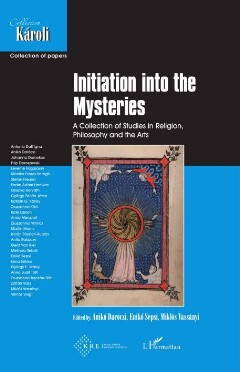Page 76 [76]
FILIP DOROSZEWSKI
öpyıa must be understood as a metaphor here. Much in the same figurative
vein, Didymus the Blind (313-398) mentions in his commentaries the öpyıa
of truth and dpyta of spiritual law.**
In one of his hymns, Synesius of Cyrene employs the term in a poetic
contemplation on the mysterious way in which Christ was engendered by
the Father.‘ Finally, Nonnus of Panopolis applies the term in the Paraphrasis
to Jesus’ parabolic style, which is hardly understandable to his disciples, and
also to the words of God handed down by Jesus to his followers.*®
DISPUTABLE PASSAGES
As we have seen, none of the 84 instances mentioned above refers to an actual
Christian celebration or rite, even if some of the passages clearly speak of
Christian doctrine. Still, there are two more occurrences of dpyta, both
from Eusebius of Caesarea, the precise meaning of which cannot be as easily
determined as in the previous cases. The first occurrence is found in Historia
Ecclesiastica 2.1.13 and the other in Vita Constantini 4.22.1. In the following
part of this section, we will look at these passages in more detail.
H.E. 2.1.13 is a passage that briefly retells the narrative of Acts 8.26-39,
the account of the Ethiopian dignitary baptized by Philip the Evangelist.
Baptism is the leading theme of the eighth chapter of Acts, which describes
Philip’s missionary journey after he fled persecution in Jerusalem. Chapter
eight starts with Philip’s arrival in Samaria, where he evangelizes and baptizes
its inhabitants, including Simon the Magician; it then tells how the apostles
Peter and John came to support Philip, and it concludes with the baptism
of the Ethiopian. The same sequence of events occurs in Eusebius’ retelling
of Philips journey in H.E. 2.1.10-13. As Eusebius often closely follows Acts
in the second book of the Historia Ecclesiastica, we can take for granted
that this time he also had Acts in mind, if not in front of him, and that he
assumed his audience would be familiar with their narrative.” In his version
of the Ethiopian’s account, Eusebius does not mention the rite of baptism. He
focuses instead on the dignitary’s conversion and its consequences for his
country:
>: Zach. 2.250.4 tä fig aAndelag öpyıa, Eccl. 310.16 tä ölpyıa ... TOO nvevnatıkoü véuov.
H. 5. 90-91 nepi oäg öpyta BAdotag / Ta Mavappyta Xopedow; see Seng, Untersuchungen, 109.
16.111 où pBeyyecı öpyıa uödwv, 17.90-91 öpyıa ubOwv / buetepwv Avepnva; see Doroszewski,
Judaic Orgies, 293-294.
Alanna Nobs, Acts and Subsequent Ecclesiastical Histories, in: The Book of Acts in its Literary
Setting, Grand Rapids, Eerdmans 1993, 155-156. See also H.E. 3.25.1 in which Eusebius says
that of all the NT books, that of Acts is second in importance only to the Gospels.
55
56
57
s 74 +
Daróczi-Sepsi-Vassányi Initiation 155x240.indb 74 6 2020. 06.15. 11:04:14

